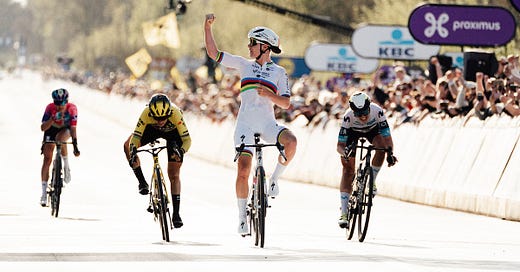5 conclusions from the women's Tour of Flanders 🇧🇪
Analysing performances from Kopecky, her breakaway companions, Lippert leading the transfer market, patience for Pieterse and Lild-Trek, and Alice Wood's expert commentary
Hi Subscribers,
Here are five conclusions from the women’s edition of the Tour of Flanders.
Remember, there’s a 20% sale on annual subscriptions right now. To take advantage of this, click on the link below.
Daniel 🫶
Opposition plays into Lotte Kopecky’s hands 🇧🇪
It’s difficult to assess Kopecky’s overall form following her victory in the Tour of Flanders and her record-setting third win in the race. Ultimately, form doesn’t matter when you win, and the world champion appeared at ease for most of the proceedings. Despite often riding into the wind and not sticking closely to her teammates’ wheels, she was rarely challenged.
She matched the accelerations from Pauline Ferrand-Prévot on the Kwaremont and maintained her position on the Paterberg. The flat run-in saw complete cooperation from the four riders in the break, with no attacks coming from Lippert, Ferrand-Prévot, or Niewiadoma. The Canyon rider at least tried to make things interesting by launching her sprint early, but that didn’t ruffle Kopecky one bit; the world champion brushed everyone aside in the final 150 meters. The SD Worx leader never attacked, never had to close a significant gap, and looked comfortable. Having Mischa Bredewold as a teammate obviously helped.
When the race lost Elisa Longo Borghini to a crash and subsequent concussion, Kopecky saw her sternest competitor leave the race. Still, there should have been more from the riders in the break - regardless of the headwind in the closing stages. Any gap created after the Paterberg would have been Kopecky’s to close, given her status as the race favourite and the best sprinter, but there were no gambles or risks with an inevitable outcome deciding the race.
Annemiek van Vleuten summed up the situation on NOS.
“Everyone rode in the group, there was no attack. It wasn’t made very difficult for her, to my surprise. Then you know that Kopecky has a great chance. They didn’t make it difficult for her. […] I don’t understand why not. Niewiadoma and Ferrand-Prévot aren’t very fast. Lippert is so that she’s taking a chance, okay… But they just rode her to the finish line.”
Van Vleuten is obviously speaking from the position of a two-time Flanders winner and as a rider who had the capacity to attack at will throughout her career, and while podiums are huge successes in their own right, more could have been done in the closing kilometres to break up the race.
You can argue that they didn’t attack from the group of four in the men’s race, but the win was already out of reach by that point.





